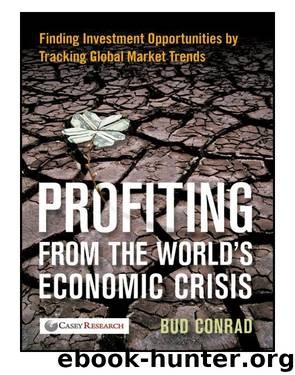Profiting from the World's Economic Crisis by Bud Conrad

Author:Bud Conrad
Language: eng
Format: epub
Publisher: Wiley
Published: 2010-03-24T04:00:00+00:00
Chapter 9
What the United States Can Learn from German and Other European Hyperinflations, and from China Today
The entire first two sections of this book laid the foundational economic forces and massive response to the current crisis in terms that lead toward dollar debasement. So, in contrast to the two cases of modest deflation during debt deleveraging described in the previous two chapters, I move here to show examples of inflation, and just how extreme it can become. Most of us Americans have not experienced how destructive inflation can become and so tend not to worry that it could get out of control. In fact, many of the brightest observers who predicted serious problems of our current crisis also believe that we will follow a path of deflation for quite a while. They point to low interest rates and low prices for houses as examples that deflation has the upper hand. So let’s put our own situation in perspective by examining examples from the other end of the spectrum of how inflation completely destroyed several European currencies in the aftermath of World War I.
Our stock market bubble of 2000 became the housing bubble of 2006 and has now become the credit crisis. With the U.S. government trying to paper over each successive crisis, federal deficits have spun out of control. Likewise, the Federal Reserve has debased its balance sheet with all manner of toxic waste, seriously undermining the long-term strength of the currency. And now we are on the path to the next logical step in the progression: a currency crisis.
The most widely noted of the currency crises is Germany’s extreme inflation in the wake of World War I. The steps that brought Germany to its currency collapse in 1923 were extreme, but they come from some of the same potential weaknesses the United States is facing. I’ll make a brief comparison of the United States to Germany, Austria, Hungary, and Poland, with a comparison that may surprise you. Also, as China has become the new emerging giant, I’ll examine its monetary situation.
In the early 1920s, Germany was buried under the weight of insurmountable reparations payments to the war’s victors, so it took the path of huge government deficit spending, covered by the printing press. As a consequence, the German currency quickly imploded to such an extent that housewives found it more economical to burn their paper money to heat the house rather than spend it on goods at the store.
In fact, the movements were so extreme that I found it difficult to even create this chapter’s figures to illustrate the situation: I had to use logarithmic scales of many cycles just to put the data on one page. The data comes from the classic book, written in 1931 by Constantino Bresciani-Turroni, called The Economy of Inflation—A Study of Currency Depreciation in Post-War Germany. I optically scanned pages of the book, corrected errors, and developed the charts. Although the book contains many charts, Figure 9.1 provides a summary of the major economic measures.
Download
This site does not store any files on its server. We only index and link to content provided by other sites. Please contact the content providers to delete copyright contents if any and email us, we'll remove relevant links or contents immediately.
International Integration of the Brazilian Economy by Elias C. Grivoyannis(75619)
The Radium Girls by Kate Moore(11634)
Turbulence by E. J. Noyes(7717)
Nudge - Improving Decisions about Health, Wealth, and Happiness by Thaler Sunstein(7261)
The Black Swan by Nassim Nicholas Taleb(6782)
Rich Dad Poor Dad by Robert T. Kiyosaki(6191)
Pioneering Portfolio Management by David F. Swensen(6089)
Man-made Catastrophes and Risk Information Concealment by Dmitry Chernov & Didier Sornette(5671)
Zero to One by Peter Thiel(5503)
Secrecy World by Jake Bernstein(4402)
Millionaire: The Philanderer, Gambler, and Duelist Who Invented Modern Finance by Janet Gleeson(4113)
The Age of Surveillance Capitalism by Shoshana Zuboff(3999)
Skin in the Game by Nassim Nicholas Taleb(3978)
The Money Culture by Michael Lewis(3857)
Bullshit Jobs by David Graeber(3843)
Skin in the Game: Hidden Asymmetries in Daily Life by Nassim Nicholas Taleb(3736)
The Dhandho Investor by Mohnish Pabrai(3573)
The Wisdom of Finance by Mihir Desai(3538)
Blockchain Basics by Daniel Drescher(3339)
